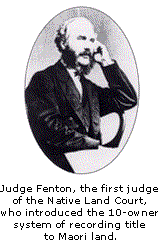How the land was lost
Land Sales
In the years up to the 1870s, there was increasing European settlement around Te Roroa's land by missionaries, gum diggers, flax and timber traders, and service people such as storekeepers.
In the 1870s, negotiations began for the sale of large areas of Te Roroa land to the Crown. Under the Treaty of Waitangi, the Crown had the first option to buy land that Māori owners wanted to sell. Te Roroa were willing sellers because they wanted more Europeans to come and live among them, so as to provide new goods and services to their communities.
From about 1870, the Crown was eager to purchase more land as quickly and cheaply as possible in order to develop farming and forestry. Crown land purchase agents were sent to persuade Māori to sell. They had money with them so they could pay tamana to individuals to encourage them to sell their land.
The Crown wanted to buy most of Te Roroa's land. Te Roroa were willing to sell, but they wanted to keep certain areas - wahi tapu, traditional mahinga kai, and papakainga - out of the sales.
How the Boundaries were Marked
Māori chiefs used 'oral maps' to mark the boundaries of their land. The names of significant landmarks were held in the tribe's memory through stories that were told about the ancestors who named them and the reasons why they were named. Thus, the people knew their land, talked about it, and 'mapped' it by relating these stories. This 'oral map' served two purposes: it marked the key features and boundaries of the land and it kept the history of the people alive.
The Europeans who came to Aotearoa, on the other hand, brought with them European tradition of making maps. They recorded the official boundaries and key features of land areas by drawing lines, symbols, and words on paper. European maps did not have the very personal aspect to them that Māori oral maps did.
The Role of the Native Land Court

Māori traditional attitudes to land were very different from the European's concept of ownership. To Māori, land belonged to the whole tribe for all time. Those who currently occupied and used the land had inherited it from their ancestors, going right back to Papatuanuku, the earth mother. Māori saw themselves as guardians or trustees of the land, holding it collectively and caring for it for the benefit of future generations. When Te Roroa sold land, they believed that they still retained their spiritual relationship with the land and remained its guardians for the future.
Whenever Māori landowners wanted to sell land, the law said that they had first to apply to the Native Land Court to register their ownership. The land then had to be surveyed and the court would determine who officially owned the land. Only after that could the sale go ahead.
Around this time, when the Native Land Court decided who owned a block of land, it registered the ownership of the block in the names of just 10 'owners'. These 10 people may not have been the ones traditionally entitled to inherit the guardianship of the land, but the land court registration system gave them the legal right to sell the land. All those who were not named among the 10 owners were disinherited of their tribal land.
Next: Case Study: Kaharau and Te Taraire
This page was last updated: